
|
About OgreCave and its staff
|

|
by Lee Valentine
Ah, Christmas – a perfect time to take convicted criminals and lead them on an expeditionary land grab in Hell itself. At least that's what Asmodée Editions would have us believe in their December 2009 board game release Claustrophobia. Designed by the French-speaking game designer CROC, this two-player board game is set in the early 17th century in Asmodée's Hell Dorado game world. Nevertheless, it features art and themes that could have easily been drawn from horror films like Silent Hill, sci-fi films like Mutant Chronicles, or even video games like DOOM. One player plays the invading humans, while another manages the demons defending Hell's prime real estate.
Game Appearance, Packaging, and Components
The game contains 17 miniatures, including one miniature each of the Redeemer and the Demon. There are two copies of the giant, polearm-wielding Condemned Brute (an anti-hero working for the human side of the game). There are two Condemned Blades for Hire (again, human anti-heroes). Lastly, there are 11 troglodyte miniatures, which look like tiny, vicious, toothy goatmen. All the miniatures thankfully come fully painted. As I lack the necessary patience to paint miniatures, I was pleased to find that I wasn't going to have to sit by and stare at a bland, gray collection of plastic miniatures this time around. While an occasional brush stroke misses a detail here or there, the miniatures all look great. The figures were not inked, highlighted, or dry brushed, but otherwise look as good as most high-end pre-painted miniatures on the market. The sculpts are well-detailed and interesting, down to the fact that all the humans but the Redeemer have their primary weapons chained and shackled to their wrists to avoid dropping them. Each Brute is reminiscent of the blade-wielding giant "Red Pyramid" from Silent Hill, only with a Hannibal Lecter mask.
The game is played on a board made up of tiles depicting tunnels and rooms, which are pieced together as the humans explore it. The artwork on the tiles is emotionally dark and stylized, representing hellish catacombs that the humans will be exploring. These tiles are very thick and durable, making up much of the weight of the overall game. The game includes 50 full-color playing cards to handle a wide variety of different game mechanics. All are printed on a nice stock, which is thick enough, but doesn't seem to have the spring of true playing card stock. The human characters each have a character reference card that slides into a custom-formed, flexible, black, plastic tray. Character cards are printed on thick chipboard. There are slots to hold dice rolls assigned to the characters, holes to put damage pegs in, and other interesting design features. In addition to an eye-catching, sturdy box, the internal packaging design is very well thought out. I supplied a few small gripseal bags to separate out the tokens, but everything in the game has its own slot or space. It all fits together tightly – I was able to turn the box upside down and on its side, and nothing moved out of its intended space in the box. That said, the molded plastic box insert to hold the components in place was not very sturdy, and before I had even played the game it was cracking in the corners. The plastic trays to hold the character cards are made of similar materials, but I'm less concerned about them, because they don't have to endure the stress of maintaining nearly six pounds of game in order during ground shipment. The box insert was of greater concern to me, making me suspect that the game shouldn't be stored indefinitely on its side.
Rules The game's turns are broken up into human and demon phases. The human sets up his turn (performing certain basic decision-making and maintenance actions), then activates his miniatures one at a time, then the demon sets up his turn and activates his miniatures one at a time. The combat and movement system is pretty standardized, but the setup phases for each player are starkly different. The game's setup phases are premised on giving each player a menu of options, but limiting which options can be selected from by the use of the results on six-sided dice. For instance, during the human's setup (or "Initiative") phase, the human player rolls a number of D6 equal to his living humans, and assigns each of those dice to a human character. As each human has exactly six Lines of Action (or combat postures), this locks in the combat statistics for that character for the rest of the turn. Later during combat, as a human character takes damage, he assigns a damage peg next to a specific Line of Action of his choice. During subsequent setup phases, if he assigns an initiative die to a character whose corresponding Line of Action is already damaged, the character is temporarily Exhausted and suffers severe combat penalties. When all of a character's Lines of Action are damaged, he dies and is removed from play. The demon player, in contrast, has a "Board of Destiny". He rolls dice and assigns individual dice to his menu of options on the board and it gives him certain advantages either in this turn or in future turns. An example action, "Sounds from the Deep" lets the demon player bank Threat Points, which can be spent later to bring out more troglodytes or even a demon. Another action allows the demon player to draw a villainous Event card to play later when it will hurt the human player the most. While the humans' Initiative phase allows primarily for tactical decision making, the demon's Board of Destiny allows for decisions which are either immediate or which have long-term strategic impact. Combat is simple. A character rolls a number of dice equal to his Combat score. Any die which equals or exceeds his target's Defense rating scores a hit. Humans, as noted, have their Lines of Action affected by damage that they sustain. Demons merely accrue damage up until their total hit points and then die. Troglodytes are a relentless army of cannon fodder – all troglodytes on a tile are targeted simultaneously and one troglodyte is removed for every successful hit done to the horde.
Scenarios While the Scenarios are diverse in nature, the human side of the scenario can always be further customized using a point-cost system. This method helps to provide a lot of competitive replay value for the game if you tire of the six included scenarios and the bonus web scenario. There are even options to handicap one side or another if one player is more experienced than the other. I have not played all the scenarios yet, but what I have tried seemed to be completed in about 70-80 minutes, a bit longer than the 45 minutes per game advertised by the manufacturer. Since I had not internalized the Lines of Action for each human and the Board of Destiny, I think play time will decrease with experience.
Gameplay The game has relatively little downtime for either player, and feels faster paced than it actually is. While it depends on the scenario, as a general rule the humans are playing a largely man-on-demon tactical game. In contrast, the Board of Destiny allows the demon player to amass a variety of cards and critters to deploy as he sees fit, allowing him to engage in more strategic planning.
One thing that bothered me about gameplay was the amount of table space required to play the game. Since you are effectively building a maze out of tiles, and that maze has no pre-determined constraints (other than the number of total tiles), the game map can easily start filling up the table edge-to-edge. As the human player, I regularly had to move my characters cards, counters, etc. to make room for the map tiles. The rulebook does not cover space limitations, and since the tiles are squares measuring over 6 inches across, this was occasionally trying. If you could play Arkham Horror on your table, then you can probably manage Claustrophobia. It'll be tough to play on a small kitchen table, and forget about playing it on that little coffee table you use for chess games. Still, I didn't downgrade the rating of the game because of this – I'd prefer to have to occasionally readjust a tile or to play on a larger table in exchange for having nicely sized tiles and miniatures.
Conclusions The human warriors are easier to play for a novice player than the demon. I explained how to play the humans to a friend in around five minutes. This makes the game easy to enter into, but very engaging nonetheless. Given the ability to build custom teams of humans, plus over half a dozen available scenarios (six in the game plus a web extra), I feel that the game has a lot of replay value already. If the game does well in the marketplace, its design is very compartmentalized, making it easy for Asmodée to expand in the future by adding some extra cards, some extra tiles, an extra type of demon, or more scenarios. I feel secure that Claustrophobia is a good gaming investment overall. I can't recommend Claustrophobia to Eurogame purists who like a minimum of dice rolling in their games. Similarly, if you need a small, easily portable game, this is not for you. I can strongly recommend this game to anyone who likes fast-paced, American-style, action-oriented, miniatures board games as well as to anyone who in intrigued by the war against Hell themes featured in Claustrophobia.
For Retailers Lee's Ratings:
Overall: A- (a light game, but with interesting thematic and experiential elements) Links
|
||||
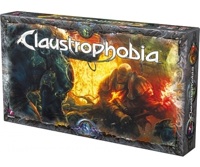 Claustrophobia
Claustrophobia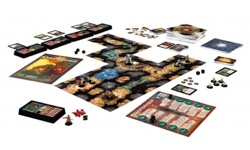 The box, weighing in at about 5.5 pounds, features an intense picture of
a horned demon fighting an armored cleric called a Redeemer. The back
of the box includes a picture of the components and a brief description
of the thematic background of the game.
The box, weighing in at about 5.5 pounds, features an intense picture of
a horned demon fighting an armored cleric called a Redeemer. The back
of the box includes a picture of the components and a brief description
of the thematic background of the game.
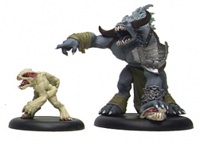 One problem with the figures is differentiating them. The only way to
tell apart the two Condemned Brutes is to look at their hair color. The
same is true of the Condemned Blades for Hire. In the artwork on the
character reference cards, the Condemned Blades for Hire are also
wearing different colored masks (one red and one blue), but my figures
both had red masks and just different hair. This, more than any of the
actual mechanics I will describe later, slowed down my gameplay
sometimes. I wish a number or some other more obvious marking had been
used to help differentiate the pairs of Condemned warrior models.
One problem with the figures is differentiating them. The only way to
tell apart the two Condemned Brutes is to look at their hair color. The
same is true of the Condemned Blades for Hire. In the artwork on the
character reference cards, the Condemned Blades for Hire are also
wearing different colored masks (one red and one blue), but my figures
both had red masks and just different hair. This, more than any of the
actual mechanics I will describe later, slowed down my gameplay
sometimes. I wish a number or some other more obvious marking had been
used to help differentiate the pairs of Condemned warrior models.
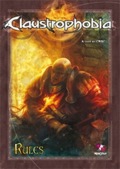 The rulebook itself has full-color, glossy printing with plenty of
examples and images. It is very well done. Overall, I found that the
rules of the game were clear in the rulebook. There were a couple of
minor errors in the rulebook that were corrected on the game's website,
but most of these weren't very significant. Claustrophobia does
have one truly unfortunate error in it. The game was originally
designed for a French-speaking audience, and some of the demon's Board
of Destiny powers were intended to be limited to once per turn (while
others could be activated repeatedly on a given turn). In the English
version of the rules, however, a mistranslation tells us that those
powers are "once per game", a very major difference in play. Thankfully
this is only one phrase in the rulebook and isn't on any of the other
printed components of the game. Since this error was a single phrase
mistranslation, I didn't severely deduct from the game's overall rules
clarity in my ratings below.
The rulebook itself has full-color, glossy printing with plenty of
examples and images. It is very well done. Overall, I found that the
rules of the game were clear in the rulebook. There were a couple of
minor errors in the rulebook that were corrected on the game's website,
but most of these weren't very significant. Claustrophobia does
have one truly unfortunate error in it. The game was originally
designed for a French-speaking audience, and some of the demon's Board
of Destiny powers were intended to be limited to once per turn (while
others could be activated repeatedly on a given turn). In the English
version of the rules, however, a mistranslation tells us that those
powers are "once per game", a very major difference in play. Thankfully
this is only one phrase in the rulebook and isn't on any of the other
printed components of the game. Since this error was a single phrase
mistranslation, I didn't severely deduct from the game's overall rules
clarity in my ratings below.
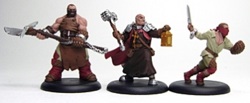 The pressure is on the humans after just a few turns. Oddly enough, I
found that if I spread out my humans in different directions when I
explored, the rules often prevented troglodytes and the demon from being
added to the board. Once I picked a passage to go down, troglodytes
started coming up behind me fast. You'd expect that the guy moving
"point" down a tunnel would be the one getting jumped, but the rules
oddly make that one of the safest positions on the board, at least for
Condemned Blades for Hire (the optimal "point" men). The end result is
that the game is largely a cinematic chase where finding a dead end in a
tunnel could mean just that – a dead end for your characters. There are
an endless number of troglodytes, and given time, they will kill every
last human on the board. The clock is ticking... run! Damn, we've
reached a dead end. Well, there is only a demon and six troglodytes
behind us, between us and that intersection I saw back five minutes ago
– time to man up.
The pressure is on the humans after just a few turns. Oddly enough, I
found that if I spread out my humans in different directions when I
explored, the rules often prevented troglodytes and the demon from being
added to the board. Once I picked a passage to go down, troglodytes
started coming up behind me fast. You'd expect that the guy moving
"point" down a tunnel would be the one getting jumped, but the rules
oddly make that one of the safest positions on the board, at least for
Condemned Blades for Hire (the optimal "point" men). The end result is
that the game is largely a cinematic chase where finding a dead end in a
tunnel could mean just that – a dead end for your characters. There are
an endless number of troglodytes, and given time, they will kill every
last human on the board. The clock is ticking... run! Damn, we've
reached a dead end. Well, there is only a demon and six troglodytes
behind us, between us and that intersection I saw back five minutes ago
– time to man up.